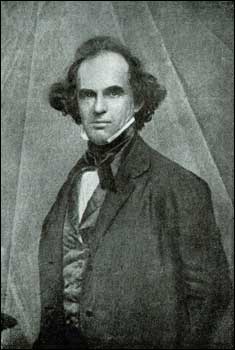
Hawthorne’s writing consistently lifts a light to illuminate our souls, and in several of his stories we are forced to come face to face with hypocrisy—the false pretense of goodness which disguises inner evil. From the religious excesses of the Puritans to the blind optimism of the Transcendentalists, Hawthorne saw hypocrisy all around him. The result of his observations is one of Hawthorne’s darkest and most disturbing tales.
In his short story “Young Goodman Brown,” Hawthorne introduces the reader to the title character, a seemingly harmless young man, and his pretty little wife, Faith, who seems to be an allegory for all that is pure and good. One evening Goodman Brown hurries away to the forest on a mysterious errand, against Faith’s wishes, and we soon learn that he is going to a “Black Mass” in the forest. He has the best of intentions for the future, determining that “after this one night” he would return to Faith and “cling to her skirts and follow her to heaven” (9), but as the night progresses he realizes that evil is more powerful than he had imagined. As he travels along the forest road he discovers that “everyone he has ever respected is actually a vile creature in the service of Hell” (Rogers 4); he even hears the voice of Faith among the sinners, and realizes that virtue is but a dream and “evil is the nature of mankind” (Hawthorne, “Young Goodman” 31). After this terrifying revelation, Goodman Brown and Faith are about to be baptized by the devil when Brown suddenly finds himself alone in the forest in the morning. It is possible that the entire episode was a dream, but Brown’s faith in humanity has been permanently scarred and forever afterward he shrinks away from the hypocrisy of his neighbors. “Young Goodman Brown” could be seen as Hawthorne’s indictment of Puritanical hypocrisy; on the other hand, it might be seen as “everyman’s response to the darkness that lives in every human” (Howard).
 |
| gavel , a photo by s_falkow on Flickr. |
Two hypocrites figure prominently in Hawthorne’s fiction.
The first is Arthur Dimmesdale, the minister who lives as a respected man while guilty of what he himself believes to be a heinous sin. Guilt festers in his heart for years, but by the end of The Scarlet Letter a “subtle disease” has begun to convince him that he is not defined by his deeds, but by his reputation; Hawthorne informs us that “no man, for any considerable period, can wear one face to himself and another to the multitude, without finally getting bewildered as to which may be the true,” and this desensitization is worse than the guilt it conceals (188). The second hypocrite is Judge Jaffrey Pyncheon from Hawthorne’s third novel, The House of the Seven Gables. He is a man of the nineteenth century, a descendant of the Puritans, who holds a “high and honorable place in the world’s regard” (165). He is described as a “subtle, worldly, selfish, iron-hearted hypocrite” (202), and the worst kind of hypocrite—he fools even himself into thinking he is free from sin stains, and his conscience “(bears) an accordant testimony with the world’s laudatory voice” (165). If Dimmesdale and Pyncheon’s ends are deemed to be representative of a hypocrite’s fate, then it is a terrible fate indeed. While Dimmesdale’s conscience is kept raw through the years, smarting under every honor accorded him, Pyncheon’s conscience is obscured by his own pride and self-righteousness. Both of them lose their lives suddenly, the former on the scaffold of the shame that he denied so long, and the latter in the arm-chair of his cruel ancestors with whom he had so much in common.
The first is Arthur Dimmesdale, the minister who lives as a respected man while guilty of what he himself believes to be a heinous sin. Guilt festers in his heart for years, but by the end of The Scarlet Letter a “subtle disease” has begun to convince him that he is not defined by his deeds, but by his reputation; Hawthorne informs us that “no man, for any considerable period, can wear one face to himself and another to the multitude, without finally getting bewildered as to which may be the true,” and this desensitization is worse than the guilt it conceals (188). The second hypocrite is Judge Jaffrey Pyncheon from Hawthorne’s third novel, The House of the Seven Gables. He is a man of the nineteenth century, a descendant of the Puritans, who holds a “high and honorable place in the world’s regard” (165). He is described as a “subtle, worldly, selfish, iron-hearted hypocrite” (202), and the worst kind of hypocrite—he fools even himself into thinking he is free from sin stains, and his conscience “(bears) an accordant testimony with the world’s laudatory voice” (165). If Dimmesdale and Pyncheon’s ends are deemed to be representative of a hypocrite’s fate, then it is a terrible fate indeed. While Dimmesdale’s conscience is kept raw through the years, smarting under every honor accorded him, Pyncheon’s conscience is obscured by his own pride and self-righteousness. Both of them lose their lives suddenly, the former on the scaffold of the shame that he denied so long, and the latter in the arm-chair of his cruel ancestors with whom he had so much in common.
To be Continued...

No comments:
Post a Comment
Thanks for visiting! Please leave many comments, I love them!